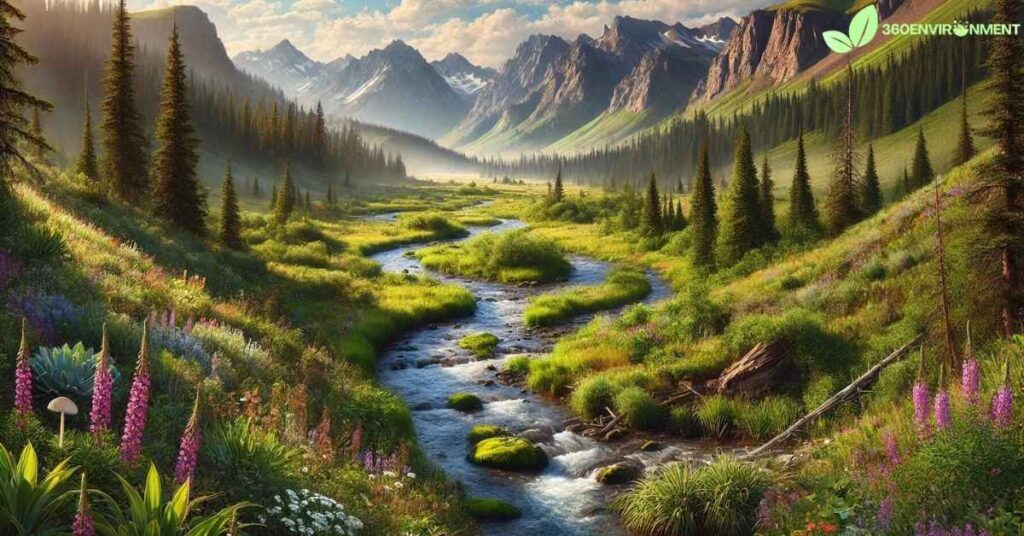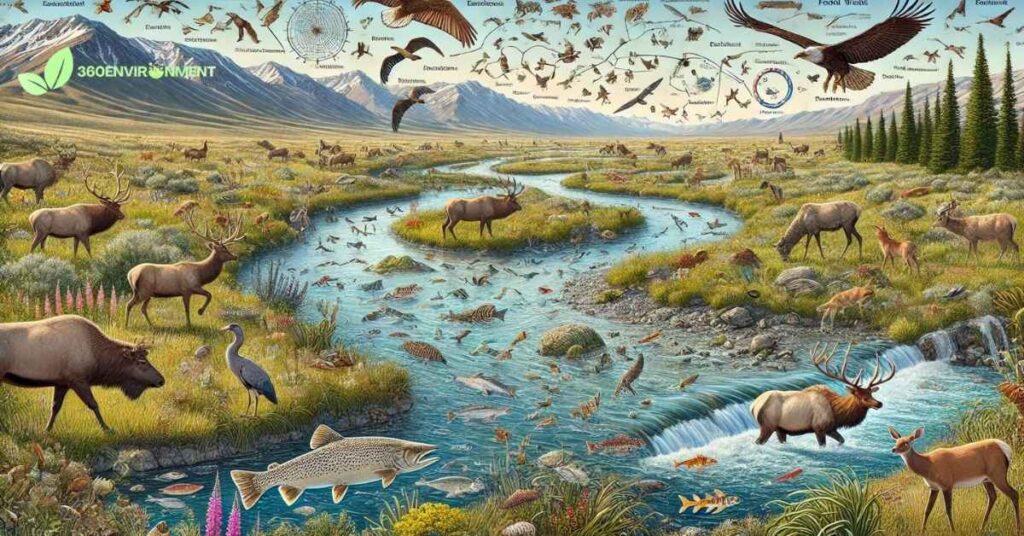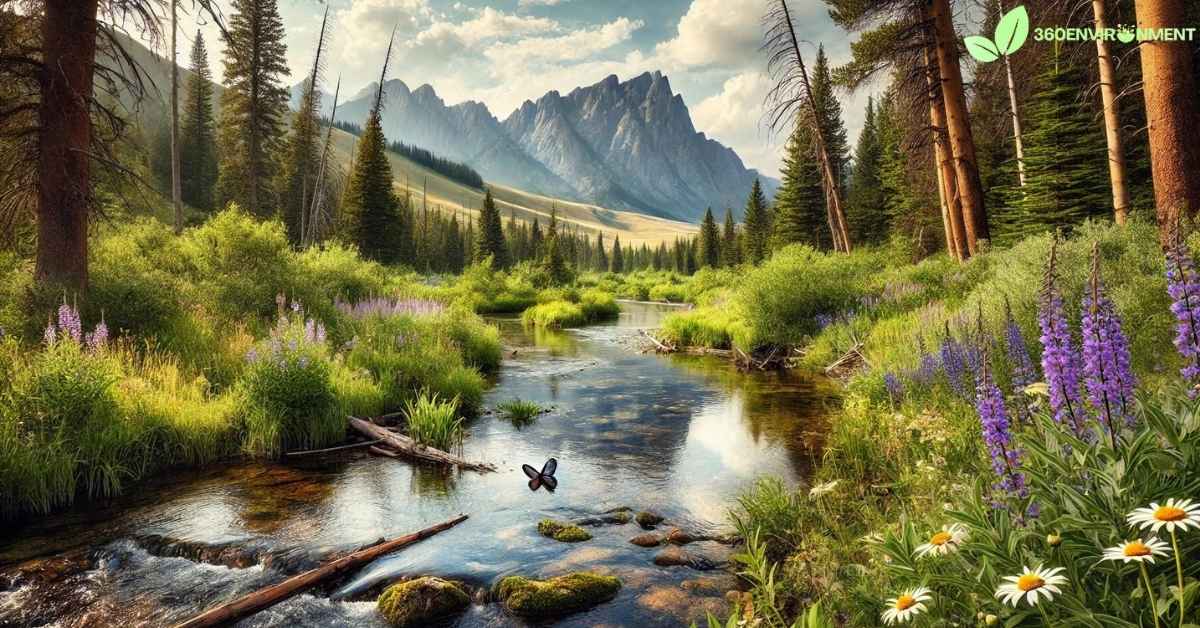Soda Butte Creek is a picturesque waterway flowing through the scenic landscapes of Montana and Wyoming, primarily within the bounds of Yellowstone National Park. Known for its pristine waters, abundant wildlife, and rich geological history, Soda Butte Creek plays a critical role in the local ecosystem. The creek meanders through alpine meadows, riparian woodlands, and rugged mountainous terrain, making it an essential part of the Greater Yellowstone Ecosystem. However, like many natural waterways, Soda Butte Creek faces challenges from both natural and human-induced pressures.
This article will delve into the environmental niche of Soda Butte Creek by exploring its diverse ecosystems, aquatic and terrestrial species, and the ecological interactions that sustain the area. Additionally, we will examine the conservation challenges the creek faces and the ongoing efforts to preserve its ecological integrity.
1. Overview of Soda Butte Creek
Soda Butte Creek originates in the Beartooth Mountains of Montana and flows southeast into Wyoming, eventually merging with the Lamar River in Yellowstone National Park. The creek is part of a larger watershed that contributes to the Yellowstone River, one of the most important river systems in the region.

1.1 Geographic Location and Physical Characteristics
Soda Butte Creek runs for approximately 20 miles (32 kilometers), with its headwaters beginning at an elevation of around 10,000 feet in the Beartooth Range. As it flows downstream, it descends through a variety of terrains, including steep mountain valleys, open meadows, and dense riparian zones. The creek’s water is cold and clear, typical of alpine streams, making it a crucial habitat for cold-water fish species and other aquatic organisms.
- Alpine and Subalpine Zones: The upper reaches of Soda Butte Creek flow through alpine and subalpine environments. These areas are characterized by rocky terrain, sparse vegetation, and short growing seasons due to the high altitude. The cold waters in this part of the creek are critical for trout species, which thrive in these oxygen-rich waters.
- Meadow and Riparian Zones: As the creek descends, it passes through open meadows and riparian woodlands. These areas provide critical habitats for a variety of wildlife, including moose, elk, and bears, which rely on the creek for water and food. The riparian zones are particularly important for bird species that nest and forage along the water’s edge.
1.2 Geological and Hydrological Features
The geology of the Soda Butte Creek area is unique and plays a significant role in shaping the creek’s characteristics. The creek is named after Soda Butte, a mineral-rich formation that once stood near the confluence of the creek and the Lamar River. The butte itself was a travertine mound formed by mineral springs, although much of it has eroded over time.
- Travertine Formations: Soda Butte Creek has historically been known for its mineral deposits, particularly travertine, a form of limestone deposited by mineral-rich waters. These formations have created unique features along the creek’s course, although human activities in the early 20th century altered much of the creek’s natural structure.
- Hydrology: The flow of Soda Butte Creek is largely influenced by snowmelt from the surrounding mountains. The creek experiences peak flow during the spring and early summer when snowmelt is at its highest. The hydrology of the creek is vital for maintaining the health of the riparian ecosystems, as well as providing essential water resources for wildlife.
2. Habitat and Ecosystem Diversity Along Soda Butte Creek
Soda Butte Creek flows through a diverse range of ecosystems, from high-altitude alpine zones to low-lying riparian areas. Each of these ecosystems provides critical habitats for various species, many of which are specially adapted to the specific conditions found along the creek.

2.1 Alpine and Subalpine Ecosystems
The headwaters of Soda Butte Creek lie in the alpine and subalpine zones of the Beartooth Mountains. These ecosystems are characterized by extreme conditions, including cold temperatures, high winds, and short growing seasons. Despite these challenges, a variety of hardy plant and animal species thrive in these areas.
- Vegetation: Alpine vegetation is sparse but highly specialized. Species such as alpine willows (Salix arctica), sedges, and mosses dominate the landscape. These plants are adapted to withstand harsh conditions, including intense ultraviolet radiation and poor soil nutrients.
- Wildlife: The alpine zones are home to several species of mammals, including mountain goats (Oreamnos americanus) and bighorn sheep (Ovis canadensis), which navigate the rugged terrain in search of food. Predators such as grizzly bears (Ursus arctos horribilis) and gray wolves (Canis lupus) also frequent the area, preying on ungulates and other wildlife.
- Aquatic Life: In the cold, oxygen-rich waters of the upper Soda Butte Creek, fish species such as the Yellowstone cutthroat trout (Oncorhynchus clarkii bouvieri) thrive. These trout are a keystone species in the ecosystem, serving as a food source for birds, mammals, and other predators.
2.2 Riparian Ecosystems
As Soda Butte Creek flows out of the mountains and into the meadows of Yellowstone’s Lamar Valley, the ecosystem transitions into a rich riparian zone. Riparian ecosystems are critical for biodiversity, as they provide water, shelter, and food for a wide range of species.
- Vegetation: Riparian areas along Soda Butte Creek are dominated by willows (Salix spp.), cottonwoods (Populus spp.), and alders (Alnus spp.). These plants stabilize the creek banks, reduce erosion, and create important habitat for wildlife. The presence of riparian vegetation also plays a key role in filtering pollutants and maintaining water quality.
- Birdlife: The riparian zones of Soda Butte Creek are teeming with bird species, particularly during the spring and summer months. Species such as the American dipper (Cinclus mexicanus), belted kingfisher (Megaceryle alcyon), and various species of warblers rely on the creek for food and nesting sites. The dense vegetation provides cover for nests, while the creek’s abundant insect life offers a steady food supply.
- Mammals: Larger mammals such as elk (Cervus canadensis), moose (Alces alces), and beavers (Castor canadensis) are frequent visitors to the riparian areas along Soda Butte Creek. Beavers, in particular, play a critical role in shaping the ecosystem. Their dams create ponds that provide habitat for fish, amphibians, and other aquatic species.
3. Biodiversity and Species Interactions Along Soda Butte Creek
Soda Butte Creek is home to a remarkable diversity of species, both aquatic and terrestrial. The interactions between these species form the foundation of the ecosystem, creating a web of interdependent relationships that ensure the health and stability of the area.

3.1 Aquatic Life and Food Webs
The aquatic life of Soda Butte Creek is dominated by cold-water species that are adapted to the creek’s fast-flowing, oxygen-rich waters. The creek’s food web begins with primary producers such as algae and aquatic plants, which support a variety of invertebrates and small fish.
- Invertebrates: Insects such as mayflies, caddisflies, and stoneflies are abundant in the waters of Soda Butte Creek. These invertebrates play a crucial role in the food web, serving as the primary food source for larger organisms such as fish and amphibians.
- Fish: The Yellowstone cutthroat trout is the most iconic species in Soda Butte Creek. These fish are not only important for maintaining the balance of the aquatic ecosystem, but they are also a critical food source for larger predators such as ospreys (Pandion haliaetus) and river otters (Lontra canadensis). The presence of cutthroat trout is a key indicator of water quality and ecosystem health.
- Amphibians and Reptiles: Amphibians such as the boreal chorus frog (Pseudacris maculata) and western toad (Anaxyrus boreas) are commonly found in the riparian areas along the creek. These amphibians rely on the moist conditions of the riparian zone for breeding and feeding. Reptiles such as garter snakes (Thamnophis spp.) are also present, preying on small fish, amphibians, and invertebrates.
3.2 Terrestrial Wildlife and Predator-Prey Dynamics
The ecosystems surrounding Soda Butte Creek are home to a wide range of terrestrial wildlife, including herbivores, carnivores, and omnivores. The predator-prey dynamics along the creek are complex and play a critical role in maintaining the health of the ecosystem.
- Herbivores: Elk, moose, and deer are among the most common herbivores found along Soda Butte Creek. These large mammals graze on grasses and browse on shrubs, helping to shape the vegetation in the area. In turn, their presence supports predators such as wolves and bears.
- Predators: Gray wolves are one of the apex predators in the Soda Butte Creek ecosystem. Wolves hunt large herbivores, primarily elk and deer, which helps regulate the populations of these species and prevent overgrazing. Grizzly bears also prey on elk, particularly during calving season, but they are opportunistic feeders and will eat a variety of foods, including fish, berries, and small mammals.
- Scavengers: Scavengers such as ravens (Corvus corax) and coyotes (Canis latrans) play an important role in the ecosystem by consuming the remains of animals killed by larger predators. This helps prevent the spread of disease and recycles nutrients back into the environment.
4. Ecological Interactions Along Soda Butte Creek
The species along Soda Butte Creek are engaged in a wide range of ecological interactions, from mutualistic relationships to competition for resources. These interactions help maintain the balance of the ecosystem and ensure the survival of various species.

4.1 Mutualistic Relationships
Several mutualistic relationships exist along Soda Butte Creek, where different species benefit from interacting with each other. One example is the relationship between beavers and other aquatic species.
- Beavers and Aquatic Species: Beavers are known as ecosystem engineers because of their ability to alter the landscape through dam-building. The ponds and wetlands created by beaver dams provide habitat for a variety of species, including fish, amphibians, and waterfowl. In return, beavers benefit from the increased availability of food in these ponds.
- Pollinators and Plants: Pollinators such as bees and butterflies are critical for the reproduction of many plant species along Soda Butte Creek. These insects help pollinate wildflowers and shrubs, ensuring the continued survival of the vegetation that forms the backbone of the riparian ecosystem.
4.2 Competition for Resources
Competition for limited resources such as food, water, and shelter is a natural part of life along Soda Butte Creek. This competition occurs both within and between species.
- Intraspecific Competition: Among fish species, individuals may compete for access to prime feeding or spawning areas. For example, cutthroat trout may defend territories within the creek that provide the best access to food or shelter from predators.
- Interspecific Competition: Competition between species is also common. For example, elk and moose may compete for access to the same food sources, particularly during the winter months when vegetation is scarce. This competition can influence the distribution and abundance of these species along the creek.
5. Conservation Challenges and Efforts Along Soda Butte Creek
Despite its remote location and relatively pristine condition, Soda Butte Creek faces several conservation challenges. These challenges stem from both natural and human-induced factors, including habitat degradation, invasive species, and climate change.

5.1 Habitat Degradation and Pollution
In the past, Soda Butte Creek suffered from the effects of mining pollution. A nearby mining operation, the McLaren Mine, discharged heavy metals such as arsenic and lead into the creek, contaminating the water and harming aquatic life.
- Mine Remediation Efforts: In recent years, significant efforts have been made to remediate the damage caused by the McLaren Mine. The mine was closed in the 1950s, and in 2014, a major cleanup effort was completed. Contaminated soils were removed, and the creek’s natural hydrology was restored, improving water quality and benefiting aquatic species.
- Ongoing Monitoring: Even with the cleanup efforts, monitoring the health of Soda Butte Creek remains a priority. Regular water quality testing ensures that any remaining contamination is identified and addressed, and efforts are made to prevent further pollution from entering the creek.
5.2 Invasive Species
Invasive species pose a significant threat to the biodiversity of Soda Butte Creek. Non-native species can outcompete native plants and animals, leading to a decline in ecosystem health.
- Aquatic Invasive Species: Invasive species such as the brook trout (Salvelinus fontinalis) have been introduced to the area and pose a threat to the native Yellowstone cutthroat trout. Brook trout are more aggressive and can outcompete cutthroat trout for food and spawning sites.
- Plant Invasions: Invasive plants such as Canada thistle (Cirsium arvense) and cheatgrass (Bromus tectorum) have also spread into the riparian zones along Soda Butte Creek. These invasive species can displace native vegetation, reduce biodiversity, and alter the structure of the ecosystem.
5.3 Climate Change
Climate change presents a long-term challenge for the ecosystems of Soda Butte Creek. Rising temperatures and changing precipitation patterns could alter the hydrology of the creek, impacting both aquatic and terrestrial species.
- Snowpack and Water Flow: Soda Butte Creek relies on snowmelt from the Beartooth Mountains to maintain its flow. As temperatures rise, snowpack may decline, leading to reduced water levels in the creek, particularly during the summer months. This could have serious consequences for fish and other aquatic species that depend on cold, flowing water.
- Shifts in Species Distribution: Climate change may also lead to shifts in the distribution of species along the creek. For example, cold-water species such as the Yellowstone cutthroat trout may be forced to move to higher elevations in search of suitable habitat, while invasive species may expand their range into previously unaffected areas.
6. Conclusion: The Vital Role of Soda Butte Creek in the Greater Yellowstone Ecosystem
Soda Butte Creek is a vital part of the Greater Yellowstone Ecosystem, providing essential habitats for a diverse array of species. From the alpine headwaters to the riparian meadows, the creek supports complex food webs, ecological interactions, and species that are critical to the health of the region. However, the creek also faces a number of conservation challenges, including the legacy of mining pollution, the threat of invasive species, and the impacts of climate change.
Through ongoing conservation efforts, such as habitat restoration, invasive species control, and climate change mitigation, the future of Soda Butte Creek can be safeguarded. Understanding the environmental niche of Soda Butte Creek is crucial for appreciating its ecological significance and the importance of preserving this unique and valuable ecosystem for future generations.

